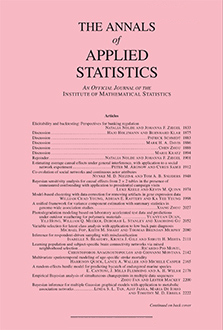Abstract
Causal mediation analysis seeks to investigate how the treatment effect of an exposure on outcomes is mediated through intermediate variables. Although many applications involve longitudinal data, the existing methods are not directly applicable to settings where the mediator and outcome are measured on sparse and irregular time grids. We extend the existing causal mediation framework from a functional data analysis perspective, viewing the sparse and irregular longitudinal data as realizations of underlying smooth stochastic processes. We define causal estimands of direct and indirect effects accordingly and provide corresponding identification assumptions. For estimation and inference, we employ a functional principal component analysis approach for dimension reduction and use the first few functional principal components instead of the whole trajectories in the structural equation models. We adopt the Bayesian paradigm to accurately quantify the uncertainties. The operating characteristics of the proposed methods are examined via simulations. We apply the proposed methods to a longitudinal data set from a wild baboon population in Kenya to investigate the causal relationships between early adversity, strength of social bonds between animals and adult glucocorticoid hormone concentrations. We find that early adversity has a significant direct effect (a 9–14% increase) on females’ glucocorticoid concentrations across adulthood but find little evidence that these effects were mediated by weak social bonds.
Funding Statement
The majority of the data represented here was supported by the National Institutes of Health and the National Science Foundation, currently through NSF IOS 1456832 and through NIH R01AG053308, R01AG053330, R01HD088558 and P01AG031719. We also thank Duke University, Princeton University and the University of Notre Dame for financial and logistical support. For assistance and cooperation in Kenya, we are grateful to the Kenya Wildlife Service (KWS), University of Nairobi, Institute of Primate Research (IPR), National Museums of Kenya, National Environment Management Authority, and National Commission for Science, Technology, and Innovation (NACOSTI). We also thank the members of the Amboseli-Longido pastoralist communities and the Enduimet Wildlife Management Area for their cooperation and assistance in the field. Particular thanks go to the Amboseli Baboon Project long-term field team (R.S. Mututua, S. Sayialel, J.K. Warutere, Siodi, I.L.) and to T. Wango and V. Oudu for their untiring assistance in Nairobi. The baboon project database, Babase, is expertly managed by N. Learn and J. Gordon. Database design and programming are provided by K. Pinc. This research was approved by the IACUC at Duke University, University of Notre Dame and Princeton University and adhered to all the laws and guidelines of Kenya. For a complete set of acknowledgments of funding sources, logistical assistance and data collection and management, please visit http://amboselibaboons.nd.edu/acknowledgements/.
Acknowledgments
We thank Surya Tokdar, Fernando Campos, and Georgia Papadogeorgou for helpful discussions.
Citation
Shuxi Zeng. Stacy Rosenbaum. Susan C. Alberts. Elizabeth A. Archie. Fan Li. "Causal mediation analysis for sparse and irregular longitudinal data." Ann. Appl. Stat. 15 (2) 747 - 767, June 2021. https://doi.org/10.1214/20-AOAS1427
Information





